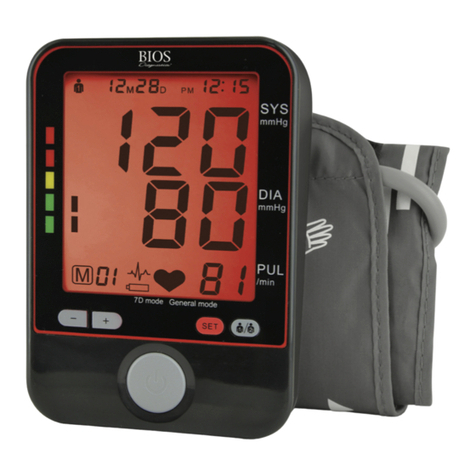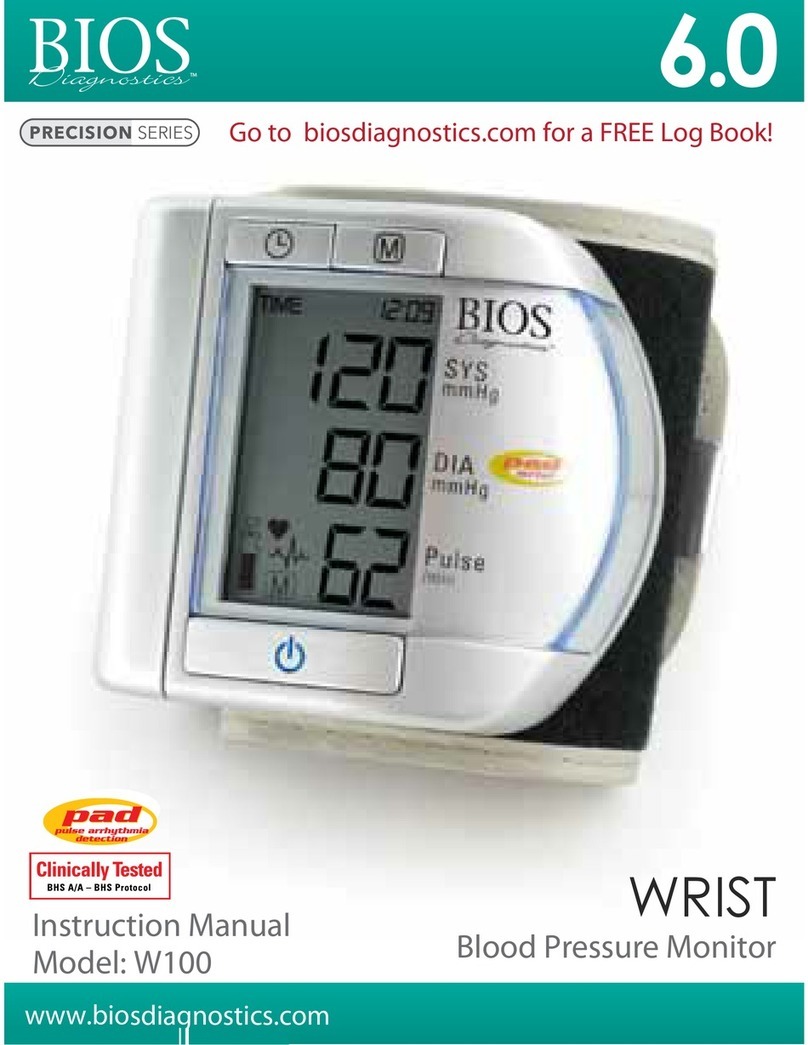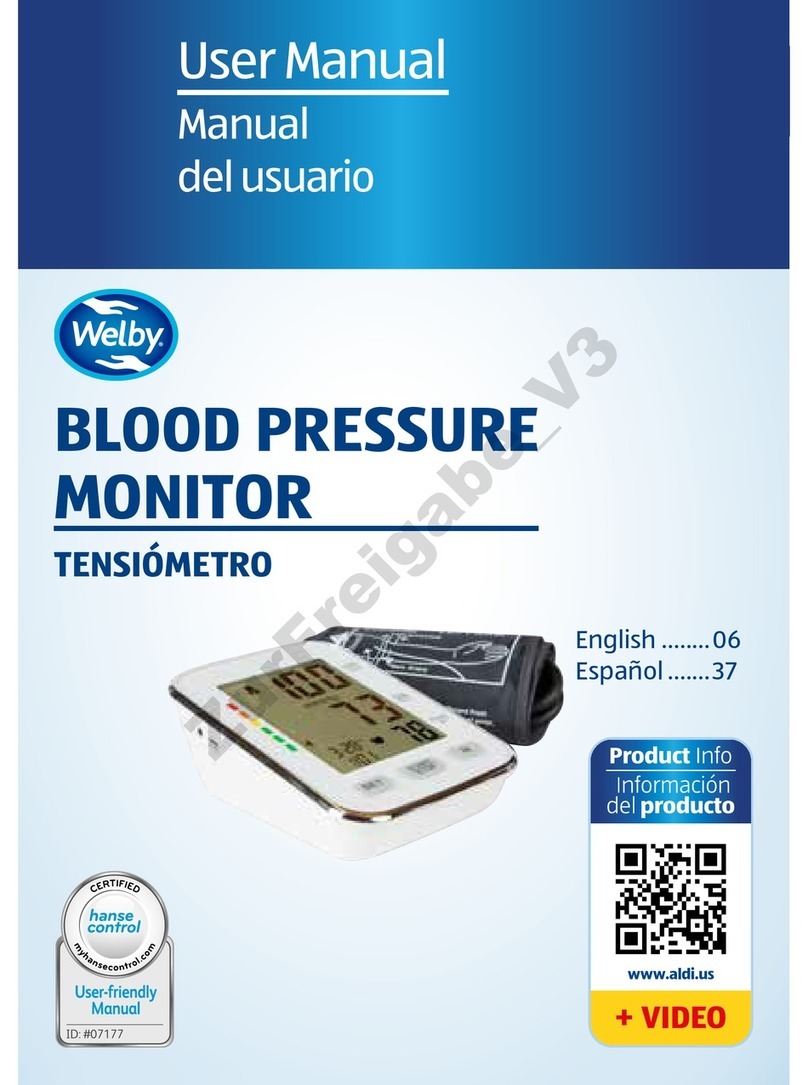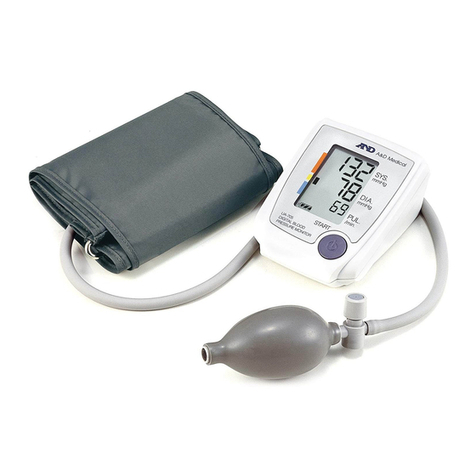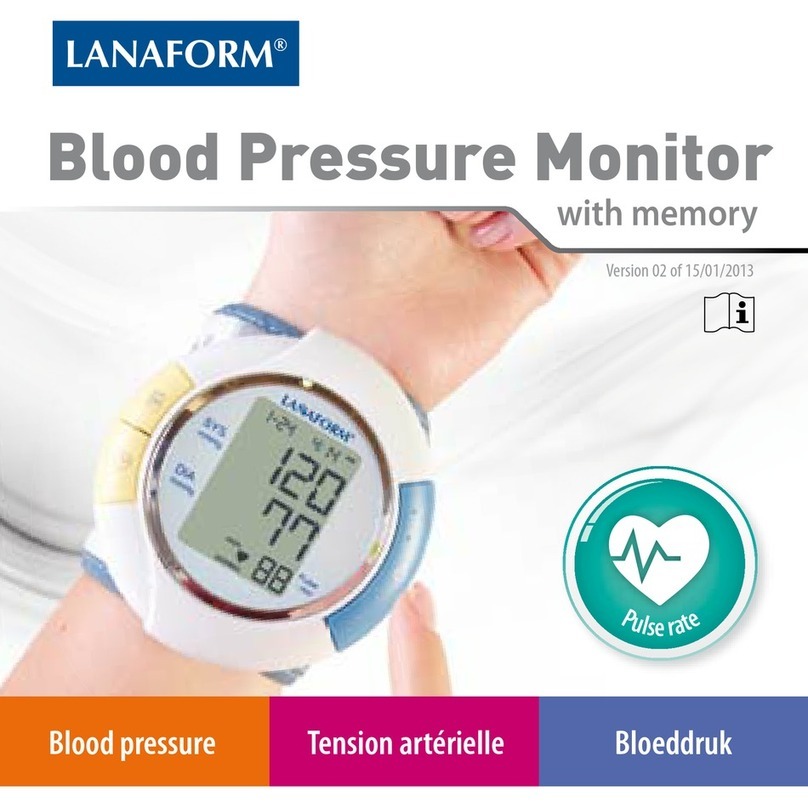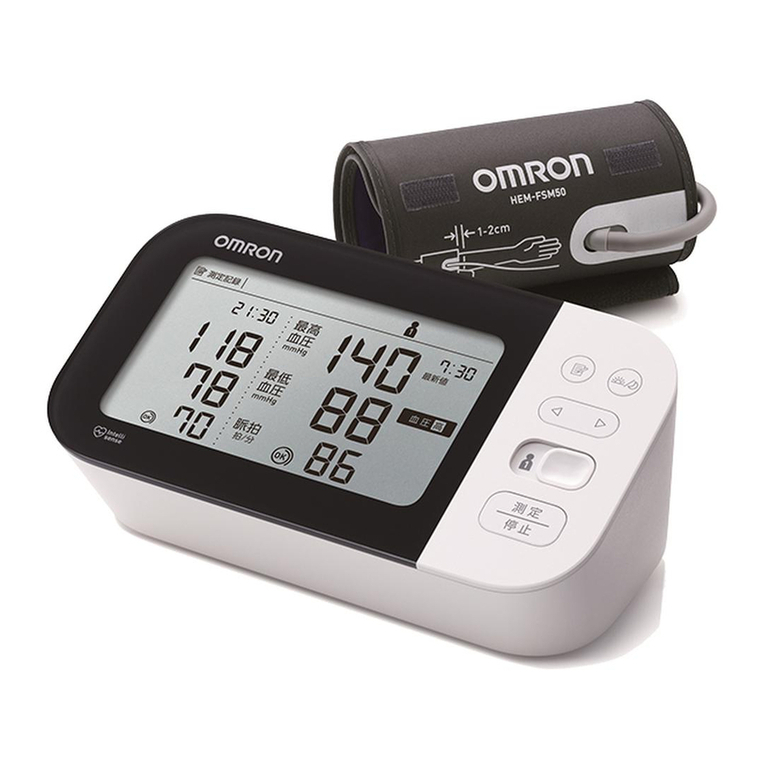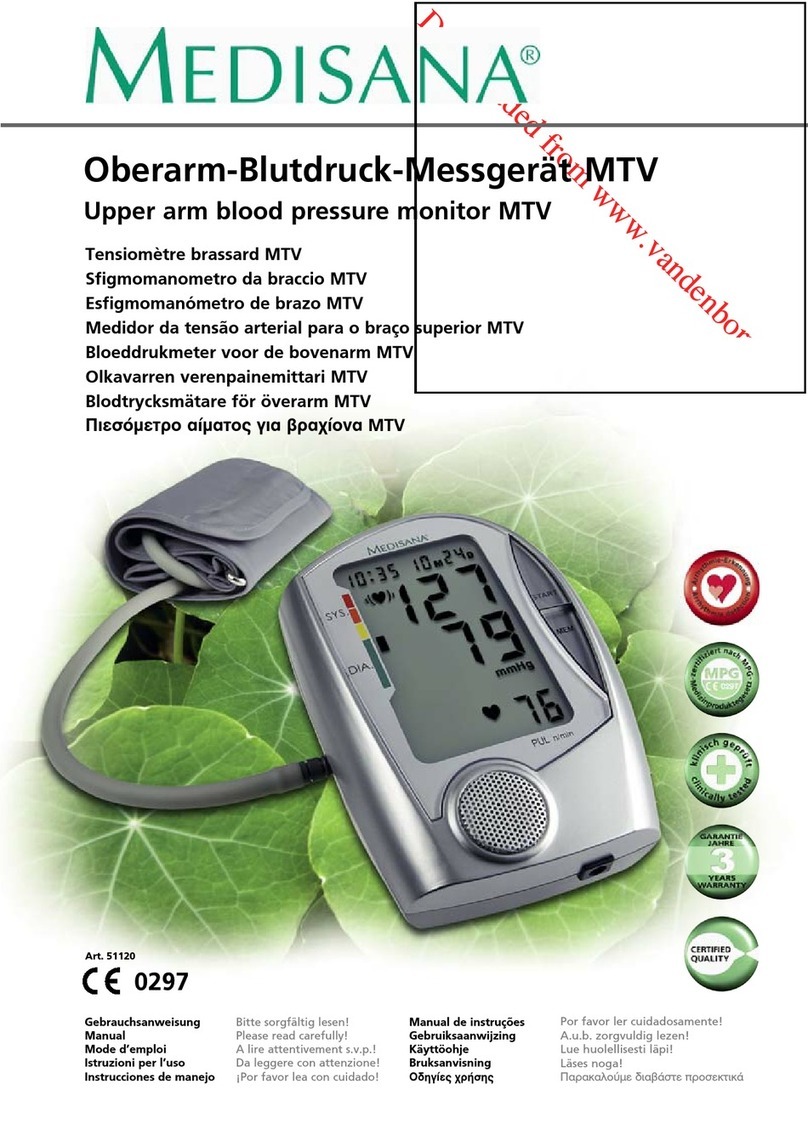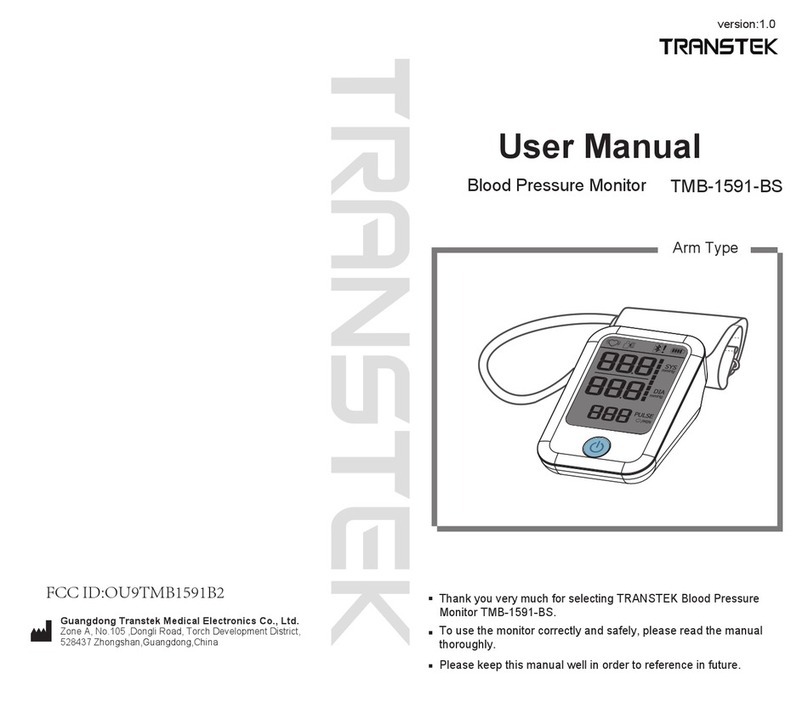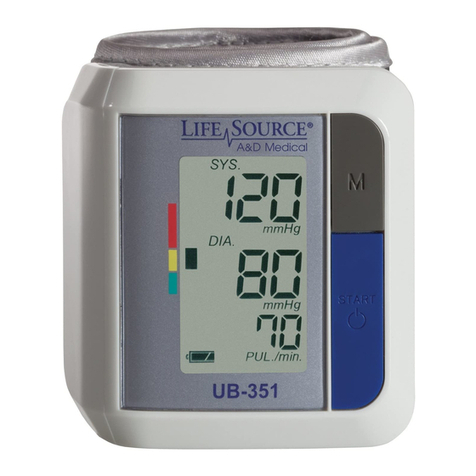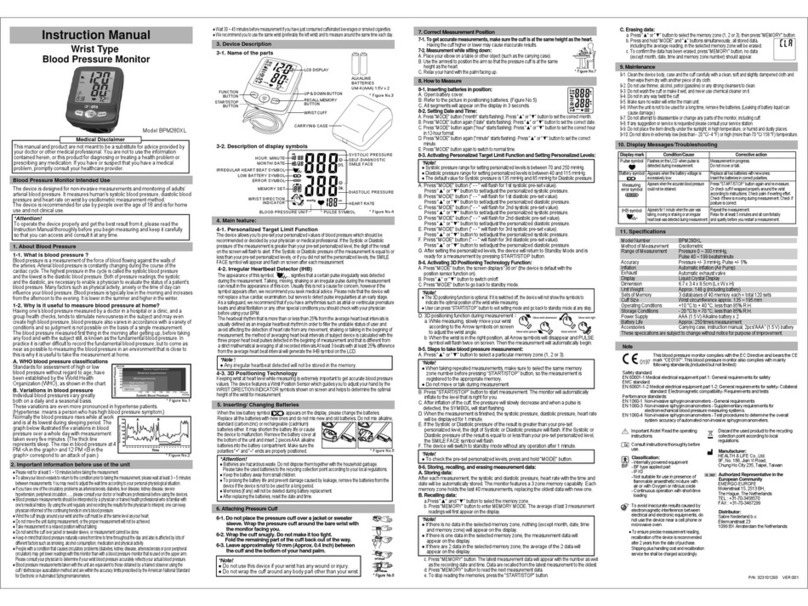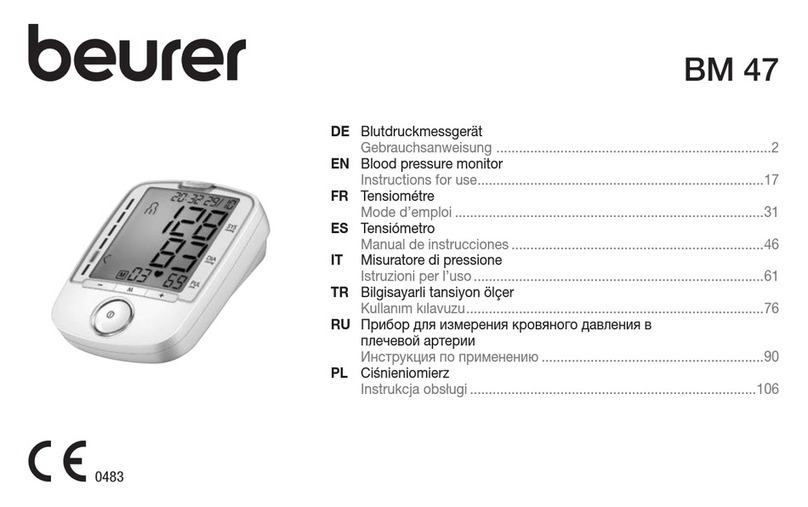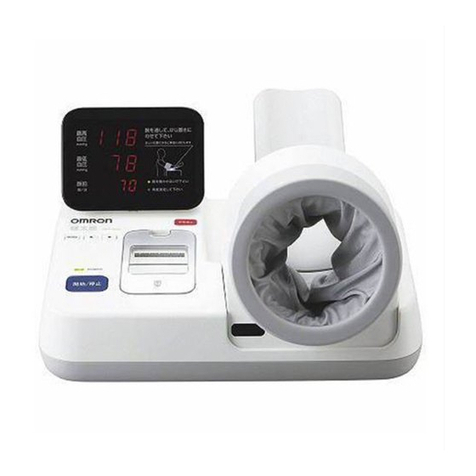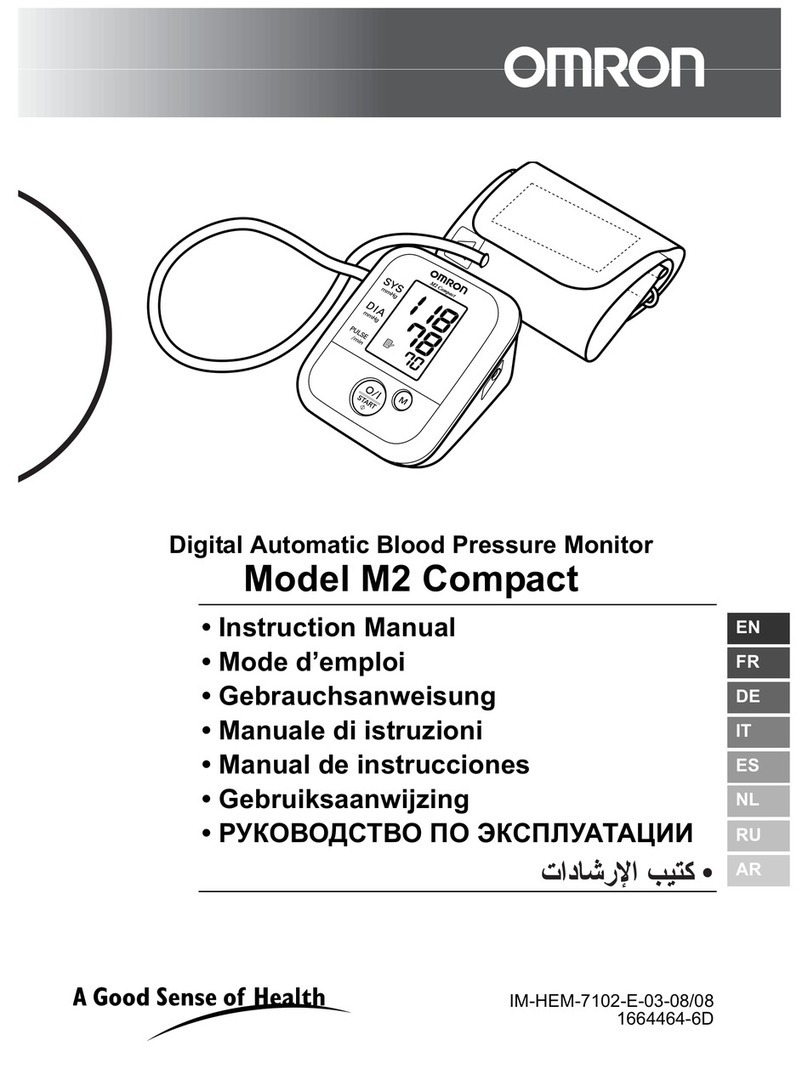BIOS BD201 User manual

Instruction Manual
Model: BD201
www.biosdiagnostics.com
Go to biosdiagnostics.com for a FREE Log Book!
EASY READ
Blood Pressure Monitor
PRECISION SERIES

Trusted by Canadians for 3 Generations.
At BIOS Diagnostics, we are proud of our legacy in blood pressure monitoring across
Canada. From the early 1930’s to 1987 we manufactured Tycos professional blood pressure
equipment for doctors and hospitals in Canada.
In the 1970’s we pioneered the first blood pressure devices for monitoring at home, and in
the 1980’s we introduced digital technology in Canada. We haven’t been counting,but we
know that millions of our home-use monitors have been used by Canadians in the last 25
years
All BIOS Diagnostics devices are developed in collaboration with physicians and clinical tests
prove their measurement accuracy. For more information on clinical tests and other BIOS
medical products, visit our website at www.biosdiagnostics.com
If you have questions about this device or blood pressure monitoring at home, email us at:
Or: Call the BIOS Diagnostics Hotline 1-866-536-2289
Office and manufacturing plant, Church St,Toronto 1934

Table of Contents
1. Introduction
1.1 Features
1.2 Important Information
1.2A Safety Information
1.2B Care of the Device
1.3 About Blood Pressure
1.4 Normal Blood Pressure Values
1.5 Common Blood Pressure Questions and Answers
2. Getting Started
2.1 About the BD201
2.2 About the LCD Screen
2.3 Inserting the Batteries
2.4 Using the AC/DC Power Adapter
3. Using the Device
3.1 Select the User
3.2 Setting Time,Date and Year
3.3 Obtaining Accurate Measurements
3.3A Before Measuring
3.3B Common Sources of Error
3.3C Fitting the Wide Range Cuff
3.4 Measuring your Blood Pressure
3.5 Discontinuing a Measurement
3.6 Memory Recall
3.7 Recall the Memory With the Power Off
3.8 Clear Measurements from Memory
3.9 Blood Pressure Assesment Software
4. Error Messages / Malfunctions
5. Care and Maintenance
6. 7 Year Warranty
7. Technical Specifications
Easy Read Blood Pressure Monitor
Instruction Manual

1. Introduction
Thank you for purchasing the BIOS Diagnostics™Easy Read Blood Pressure Monitor.Designed for convenient and
easy operation,this device provides a simple, yet accurate method to measure your blood pressure.
Your blood pressure is an important parameter that can be used to monitor your health. This device enables you to
monitor your blood pressure regularly, and maintain a record of your blood pressure measurements.You can then
use this record to assist your physician in diagnosing and maintaining a healthy blood pressure level.
1.1 Features
The BD201 uses oscillometric technology to measure the arterial blood pressure and pulse rate.The cuff is wrapped
around the arm and automatically inflated by the air pump.The sensor in the device senses weak fluctuation of the
pressure in the cuff produced by extension and contraction of the artery of the arm in response to each heartbeat.
The amplitude of the pressure waves is measured,converted in millimeters of the mercury column,and is shown on
the display.
• MemoryFeatures2 users, 90 blood pressure readings each with time and date.
• BPAssessmentIndicator displays the range between which your blood pressure values lie, according to the
WHO (World Health Organization).
• Detectsirregularheartbeat
• BIOSAveraging - Averages last 3 readings
• Time and date
This device is easy to use and has been proven in clinical studies to provide excellent accuracy. Before using the
BD201, read this instruction manual carefully and keep it in a safe place.
The blood pressure monitor meets the accuracy requirements of Hypertension Canada and has been tested for
clinical accuracy.
1.2 Important Information
Refer to the following sections to learn about important safety instructions and how to take care of the
BIOS Diagnostics™Easy Read Blood Pressure Monitor.
1.2ASafetyInformation
• Self-measurementmeanscontrol,notdiagnosisortreatment.Yourvaluesmustalwaysbediscussedwithyour
doctor or a physician who is familiar with your family history.
• Ifyouareundergoingmedicaltreatmentandreceivingmedication,consultyourdoctortodeterminethemost
appropriate time to measure your blood pressure. Never alter the dosages of any medication without direction
from your doctor.
• Yourbloodpressuredependsonseveralfactors,suchasage,gender,weight,andphysicalcondition.Italso
depends on the environment and your state of mind at the time of measurement. In general, your blood
pressure is lower when you are asleep and higher when you are active.Your blood pressure may be higher
when recorded at a hospital or a clinic and may be lower when measured in the relaxing comfort of your home.
Due to these variations, we recommend that you record your blood pressure regularly at home as well as at
your doctor’s clinic.
• Trytorecordyourbloodpressureregularlyatthesametimeofthedayandunderthesameconditions.Thiswill
help your physician detect any extreme variations in your blood pressure and thus treat you accordingly.

• MorningHypertension(>135/85mmHg):Recently,severalstudieshaveidentiedelevatedcardiovascular
risks (heart failure,stroke,angina) associated with “morning hypertension”. There is a typical rise in blood
pressure during the physiological changes from sleep to arising for the day.
• Theidealtimetomeasureyourbloodpressureisinthemorningjustafteryouwakeup,beforebreakfast
and any physical activity, and in the absence of the urge to urinate. If this is not possible, try to take the
measurements later in the morning,before you start any physical activity. Relax for a few minutes before you
record your blood pressure.
• Yourbloodpressureincreasesordecreasesunderthefollowingcircumstances:
Blood pressure is higher than normal:
— when you are excited,nervous, or tense
— while taking a bath
— during and after exercise or strenuous physical activity
— when it is cold
— within one hour after meals
— after drinking tea,coffee,or other caffeinated drinks
— after smoking tobacco
— when your bladder is full
Blood pressure is lower than normal:
— after consuming alcohol
— after taking a bath
• Thepulsedisplayisnotsuitableforcheckingthefrequencyofheartpacemakers.
• Ifyouhavebeendiagnosed with a severe arrhythmia or irregular heartbeat, vascular constriction,liver
disorders, or diabetes, have a cardiac pacemaker, or are pregnant, measurements made with this instrument
should only be evaluated after consultation with your doctor.
• Takecarewhilehandlingthebatteriesinthedevice.Incorrectusagemaycausebatteryuidleakage.
To prevent such accidents, refer to the following instructions:
— Insert batteries with the correct polarity.
— Turn off power after use. Remove and store the batteries if you are not planning to use the device for an
extended period of time.
— Do not mix different types,brands, or size of batteries.This may cause damage to the product.
— Do not mix old and new batteries.
— Remove batteries and dispose of them according to the proper regulations in your area.
— Do not disassemble batteries or expose them to heat or fire.
— Do not short-circuit the batteries.
— Do not use rechargeable batteries.
1.2B Care of the Device
For prolonged life of your blood pressure monitor,note the following instructions:
• Donotdroporbangtheunit.Preventsuddenjerks,jars,orshockstothedevicetopreventdamage.
• Donotinsertanyforeignobjectsinanydeviceopeningsorvents.
• Donotdisassembletheunit.
• Iftheunithasbeenstoredatveryloworfreezingtemperatures,allowtoreachroomtemperaturebeforeusingit.
• Donotstoretheunitindirectsunlight,highhumidity,orinplaceswithalotofdust.
• Cleanthedevicewithasoftdrycloth.Donotusegasoline,thinnerorsimilarsolvents.Carefullyremovespots
on the cuff with a damp cloth and soap. Do not wash the cuff.

1.3AboutBloodPressure
Your blood pressure level is determined in the circulatory center of your brain.Your nervous system allows your body
to adapt or alter blood pressure in response to different situations.Your body alters your pulse or heart rate and the
width of blood vessels through changes in muscles in the walls of blood vessels.
Your blood pressure reading is highest when your heart pumps or ejects blood.This stage is called your systolic
blood pressure.
Your blood pressure is lowest when the heart rests (in-between beats).This is called your diastolic blood pressure.
It is critical to maintain blood pressure values within a “normal” range in order to prevent cardiovascular diseases.
Increased blood pressure values (various forms of hypertension) have associated long and medium term health
risks.These risks concern the arterial blood vessels of your body, which are endangered due to constriction caused by
deposits in the vessel walls (arteriosclerosis).A deficient supply of blood to important organs (heart, brain, muscles)
can be the result. Furthermore,with long-term increased blood pressure values, the heart will become structurally
damaged.
There are many different causes of the appearance of high blood pressure. We differentiate between common
primary (essential) hypertension, and secondary hypertension.The latter group can be ascribed to specific organic
malfunctions. Please consult your doctor for information about the possible origins of your own increased blood
pressure values.
1.4 Normal Blood Pressure Values
Blood pressure is too high when,at rest, the diastolic pressure is above 90 mmHg or the systolic blood pressure is
over 140 mmHg.
If you obtain readings in this range, consult your doctor immediately. High blood pressure values over time can
damage blood vessels, vital organs such as the kidney, and your heart.
Should the systolic blood pressure values lie between 140 mmHg and 160 mmHg or the diastolic blood pressure
values lie between 90 mmHg and 95 mmHg, consult your doctor. Regular self-checks will be necessary.
With blood pressure values that are too low (i.e., systolic values under 105 mmHg or diastolic values under
60 mmHg), consult with your doctor.
Even with normal blood pressure values, a regular self-check with your blood pressure monitor is recommended.
This way you can detect possible changes in your values early and react appropriately.
Refer to the following table for classifying blood pressure values (units: mmHg) according to the World Health
Organization (WHO):
Category Systolic Blood Pressure Diastolic Blood Pressure
Optimal < 120 < 80
Normal < 130 < 85
High Normal 130 - 139 85 - 89
Hypertension
•Stage1:Mild 140 - 159 90 - 99

•Stage2:Moderate 160 - 179 100 - 109
•Stage3:Severe >180 >110
Isolated Systolic Hypertension >140 < 90
ImportantforCanadians: The Canadian Hypertension Education Program (CHEP) recommends that
patients with average measurements of 135mmHg (systolic) or 85mgHg (diastolic) at home be
considered hypertensive. Should your average readings be in this range, consult your physician.
For further information, see our website www.biosmedical.com.
If your values are mostly “normal” under resting conditions but exceptionally high under conditions of physical or
psychological stress,it is possible that you are suffering from so-called ”labile hypertension”. In any case, please
discuss the values with your doctor.
Correctly measured diastolic blood-pressure values above 120mmHg require immediate medical treatment.
1.5CommonBloodPressureQuestionsandAnswers
a) Why is my blood pressure reading always different?
Your blood pressure changes constantly. It is quite normal for blood pressure to fluctuate significantly (50 mmHg
to 60 mmHg) throughout the day. Blood pressure is normally lowest at night, but increases during waking hours
when the stress and activities of everyday life are highest.
mmHg
AM Time PM
Your blood pressure also increases and decreases under the following circumstances
Bloodpressureishigherthannormal:
•whenyouareexcited,nervous,ortense
•whiletakingabath
•duringandafterexerciseorstrenuousphysicalactivity
•whenitiscold
•withinonehouraftermeals
•afterdrinkingtea,coffee,orothercaffeinateddrinks
•aftersmokingtobacco
•whenyourbladderisfull

Bloodpressureislowerthannormal:
•afterconsumingalcohol
•aftertakingabath
b) Why is the doctor’s reading different from the reading taken at home?
Your blood pressure can vary due to the environment (temperature, nervous condition). When measuring
blood pressure at the doctor’s office, it is possible for blood pressure to increase due to anxiety and tension.
c) Why should I monitor blood pressure at home?
One or two readings will not provide a true indication of your normal blood pressure.It is important to take
regular, daily measurements and to keep records over a period of time. This information can be used to
assist your physician in diagnosing and preventing potential health problems.
2. Getting Started
2.1AbouttheBD201
This section describes the various components of the Easy Read Blood Pressure Monitor.
a) Blood Pressure Monitor
Cuff
Wide range cuff
Cuff connector
Air socket for
cuff connector
AC/DC socket
Memory up button
Start/Stop button
Setting
button
Memory
down
button
b) Upperarmcuff:
Wide range cuff for arm circumference 24-43 cm or 9.4” - 16.9”.
Cuffconnection:
Insert the cuff connector into the opening provided on the left side of the monitor as shown in the diagram.

2.2AbouttheLCDScreen
The LCD screen displays the systolic and diastolic blood pressure measurements along with your heart rate. It also
displays previously recorded measurements and the date and time, when the appropriate button is pressed.
User
Blood pressure
classification
Memory symbol
Memory times
Low battery
Heartbeat rhythm
Pulse rate
Irregular heartbeat
Diastolic blood pressure
Systolic blood pressure
Year/Month/Date/Time
2.3 Inserting the Batteries
Follow these steps to insert four “AA” batteries in the device.
1. Open the battery compartment cover in the direction shown.
2. Insert four “AA” batteries with the correct polarity as indicated.
3. Replace the battery compartment cover.
Attention!
• Afterthebatterywarningappears,thedeviceisblockeduntilthebatterieshavebeen
replaced.
• Pleaseuse“AA”Long-LifeorAlkaline1.5Vbatteries.
• Ifthebloodpressuremonitorisleftunusedforlongperiods,pleaseremovethebatteries
from the device.
• Donotmixoldandnewbatteries.Donotmixalkaline,standard(carbon-zinc)or
rechargeable batteries.

2.4UsingtheAC/DCPowerAdapter
You may also operate this monitor using the included AC/DC
adapter. Use only the included USB adapter to avoid damaging
the unit.
1. Ensure that the AC/DC adapter and cable are not damaged.
2. Plug the adapter cable into the AC/DC Adapter port on the top
of the blood pressure monitor.
3. Plug the adapter into your electrical outlet.When the USB
adapter is connected, no battery current is consumed.
3. Using the Device
This section describes how to get the maximum benefit from your BD201 blood pressure monitor.Follow the
instructions carefully to get an accurate measurement of your blood pressure and pulse rate.
Note: Setting the user, year, month, date and time is one sequential process
3.1 Select the User
1. Start with the power off,but with batteries or adapter inserted.
2. Press the SET button 1 time, the user will appear in the upper left
corner. Use the “+” or “-” button to choose user or
3.2 Setting the Time, Date and Year
1. Immediately after selecting the user, press the SET button, the YEAR will flash “2014”. Use the “+”
or “-” button to choose the year and press SET to store in the memory.
2. Repeat the same process to set the MONTH by using the “+” or “-” button. Press
the SET button to store it in the memory.
3. The same process is repeated to set the DATE. The date will flash and can be
changed with the “+” or “-” button. Afterwards, HOURS will begin to flash.
4. TIME; hours, and then minutes can be set following the same procedure by using
the “+” or “-” buttons. Finish the process by pressing the SET button and the
USER,YEAR, MONTH,DATE, HOUR and MINUTES will all be stored in the products
memory.
NOTE: In order to change any setting you must repeat the process and confirm each
setting by pushing the SET button.
3.3ObtainingAccurateMeasurements
Your blood pressure can vary based on numerous factors,physiological conditions, and your surroundings. Follow
these guidelines to obtain accurate and error-free measurements of your blood pressure and pulse rate.
3.3ABeforeMeasuring
• Avoideating,smokingaswellasallformsofexertiondirectlybeforethemeasurement.Allthesefactors
influence the measurement result.Relax by sitting in an armchair or at a table in a quiet atmosphere for about
5 minutes before the measurement.
• Alwaystakemeasurementsonthesamearm(normallyleft)andinthesameposture.Donotswitchbetween
right and left arms while recording your blood pressure as there may be a difference of up to 10mmHg
pressure between the two arms.
H
M

• Attempttocarryoutthemeasurementsregularlyatthesametimeofday,sincebloodpressurechangesduring
the course of the day. The ideal time to measure your blood pressure is in the morning after you wake up,
before breakfast and physical activity,and in the absence of the urge to urinate.
• Restfor5minutessittingquietlyandreleaseallthetensioninyourbody—especiallythearmmuscles—before
beginning with the measurement.Remain calm and quiet when the measurement is in process. Do not speak
or move your arm (as well as other body) muscles during the process.
• Ideally,youwillbesittingatatablewithbothfeetontheoor,andyourarmrestingonthetablewiththecuff
at heart level.
3.3B Common Sources of Error
All efforts by the patient to support the arm can increase the blood pressure. Make sure you are in a comfortable,
relaxed position and do not activate any of the muscles in the measurement arm during the measurement.Use a
cushion for support if necessary.
ATTENTION!
Comparable blood pressure measurements always require the same conditions with a peaceful and
calm environment. Ensure that you take measurements under the same conditions to obtain an
accurate estimate of blood pressure variation patterns.
• Ifthearmarteryliesconsiderablylowerorhigherthantheheart,anerroneousvalueofbloodpressureis
measured.Each 15 cm difference in height results in a measurement error of 10 mmHg.
• Aloosecuffcausesfalsemeasurementvalues.
• Withrepeatedmeasurements,bloodaccumulatesinthearm,whichcanleadtofalseresults.Consecutive
blood pressure measurements should be repeated after at least a 15 second pause or after the arm has been
held up in order to allow the accumulated blood to flow away.
3.3C Fitting the Wide Range Cuff
a) Put the end of the cuff (with fastener) through the metal ring, making
the cuff a cylinder.(Ignore this step if your cuff is already set up.)
Proper assembly allows the Velcro®to match up properly.
b) Place the cuff around your arm.Make sure the bottom edge of the
cuff is about 1” (2-3 cm) above the elbow joint. Adjust the cuff so that
the rubber tubing under the cuff lies over the brachial artery, which
runs on the inside of the arm (see Fig. B). The red material should be
over the braechial artery.
c) Pull the cuff and tighten it by attaching the Velcro®fastener. Normally,
the left arm is used,unless there is a physical reason for using the
right arm.
a)
b)
c)

d) The cuff should fit snugly around the arm, but not too tight.You
should be able to fit two fingers under the cuff.
e) Place the arm on the table (palm facing upwards) so that the cuff is at
the same level as the heart. Make sure there is no kink in the hose.
f) You can adjust the level of your arm by putting a cushion under your
arm. Ideally the cuff should be at heart level.
g) Remain seated in a comfortable room temperature for at least 5
minutes, then start the measurement.
h) For those who cannot put the cuff on the left arm, put it on the right
arm as shown.
i) Consecutive measurements will cause blood accumulation in the
lower arm which will affect the measuring results. To improve reading
accuracy, raise the arm being measured, squeeze and relax your hand
several times, then take another measurement.Another option
is to take the cuff off and wait at least 5 minutes before repeating
measurement.
j) If this device was stored in low temperature, it is necessary to
leave it in room temperature for at least 1 hour, otherwise the
measurement can be inaccurate.
Comment:
If it is not possible to fit the cuff to your left arm, it can also be placed on the right arm. However all measurements
should be made using the same arm.
Comparable blood pressure measurements always require the same conditions (Relax for several minutes before
taking a measurement).
ATTENTION:Donotuseacuffotherthantheoriginalcuffcontainedinthiskit!
d)
e)
f)
h)
i)

3.4 Measuring Your Blood Pressure
After the cuff has been appropriately positioned, the measurement can begin:
1. Press the START/STOP button until all the symbols appear on the screen. You will hear 2 short
beeps and after “0” will flash for 2 seconds. The pump then begins to inflate the cuff. The
increasing pressure in the cuff is shown on the display.
2.After the suitable pressure has been reached, the pump stops and the cuff gradually deflates.
The cuff pressure will then be displayed. In case the initial inflation is not sufficient, the device
automatically re-inflates to a high pressure.
3. When the device detects a heartbeat,the heart symbol “ ” on the display starts to flash and you
can hear a beep for every heartbeat.
4. When the measurement has been completed,you will hear a long beep and the systolic, diastolic
and pulse rate will appear on the display.
5. The measurement readings remain on the display until you switch off the device. If no button is
pressed,the device switches off itself in 3 minutes.
NOTE: The symbol “ ” will be displayed along with the reading if irregular heartbeat has been
detected during the measurement. If the “ ” symbol appears frequently (e.g.several times a week), it may
be an indication of a more serious heart problem, and you should consult your doctor.
3.5 Discontinuing a Measurement
To stop the measurement (eg. the patient feels unwell) press the START/STOP button. The device will immediately
decrease the cuff pressure automatically.
3.6 Memory Recall
This blood pressure monitor automatically stores 90 measurements for each user in its memory. The oldest record
will be replaced by the latest measurement value when there are more than 90 sets for each user.
3.7 Recall the Memory with the Power Off
Press the “+” or “-” button , the average of the last 3 measurements will be shown, or press the “-” button again
to see the most recent measurement value. Subsequest measurements can be displayed one after the other by
pressing the “+” or “-” button.
3.8 Clear Measurements From Memory
If you are sure that you want to permanently remove all stored memories, press the SET button 7 times until “CL”
appears when the power is off. Press the START/STOP button until “CL” flashes 3 times to clear the memory. After
this, press either the “+” or “-” button, the symbols “ ” and “no” will appear on the screen. This means that the
memory has successfully cleared.

3.9BloodPressureAssesmentIndicator
The bars on the left hand side of the display show you
the range within which the indicated blood pressure
values lies. Depending on the height of the bar, the
readout value is either within the normal (green),
borderline (yellow/orange) or danger (red) range.
The classification is based on standards adopted from
WHO (World Health Organization); which is recognized
by Hypertension Canada.
The indicator bar rises according to your measurement.
• Ifyourmeasurementhasonlyoneortwobars,
your measurement is in the green zone,or
“Normal” according to the WHO classification.
• Ifyourmeasurementhasthreebars,itisinthe
yellow zone, or high normal according to the WHO
classification.
• Ifyourmeasurementhasfourbars,itisinthe
orange “Stage 1 Hypertension” zone.
• Ifyourmeasurementhasvebars,itisinthered
“Stage 2 Hypertension” zone.
• Ifyourmeasurementhassixbars,itisinthered
“Stage 3 Hypertension” zone.
4. Error Messages / Malfunctions
If an error occurs during a measurement the LCD displays the corresponding error code.
Error Possible Cause Remedy
E-1 Weak signal or a sudden change in pressure Ensure that the cuff is worn correctly and mea-
sure again.Avoid movement or talking when
the cuff is being inflated.
E-2 External disturbance (eg. if there is a cell phone
near by)
Electromagnetic interferance can cause odd
behaviour in the monitor. Move away from the
source.
E-3 Appears when there is an error during the
inflation process
Make sure the cuff is wraped around the arm
properly and that the air plug is properly con-
nected to the unit.
E-5 Abnormal Blood Pressure Rest for 5 minutes and try measurement again
Low battery Replace batteries.
If problems occur when using the device the following points should be checked, and if necessary, the
corresponding measures should be taken.
SYS
WHOWorld Health Organization 2003
180
160-180
110
100-110
90-100
85-90
80-85
80
140-160
130-140
120-130
120
(mmHg) DIA
Red
Red
Orange
Yellow
Green
Green

Malfunction Remedy
The display remains blank when the device is switched
on.
1. Check batteries for correct polarity.
2. If using the AC adapter, ensure it is correctly
inserted.
The pressure does not rise even though the pump is
running.
Check the connection of the cuff tube and connect
properly if necessary.
The device frequently fails to measure the blood
pressure values,or the values measured are too low
or too high.
1. Check the positioning of the cuff and cuff tension.
The cuff should be snug but not tight.
2. Measure the blood pressure again,ensuring that
you have remained motionless for a sufficient
amount of time to ensure an accurate reading.
Every measurement produces varying results although
the instrument functions normally and the values
displayed are normal.
Note that blood pressure fluctuates continuously;
therefore measurements will show some variability.
Blood pressure values measured differ from those
measured by the doctor.
Record the daily developement of the values and
consult your doctor.
Note:Individualsvisitingtheirdoctorfre-
quently experience anxiety which can result in
a higher blood pressure reading than at home.
ForassistancecallBIOSDiagnosticsBloodPressureHotline:1-866-536-2289

5. Care and Maintenance
a) Do not expose the device to either extreme temperatures, humidity,dust or
direct sunlight.
b) The cuff contains a sensitive air-tight bubble. Handle this carefully and avoid
all types of stress through twisting or buckling.
c) Clean the device with a soft, dry cloth. Do not use gas,thinners or similar
solvents. Spots on the cuff can be removed carefully with a damp cloth and
soapsuds. The cuff with bladder must not be washed in a dishwasher,
clothes washer, or submerged in water.
d) Handle the tube carefully. Do not pull on it.Do not allow the tubing to kink and keep it away from sharp edges.
e) Do not drop the monitor or treat it roughly in any way. Avoid strong vibrations.
f) Never open the monitor. This invalidates the manufacturer’s warranty.
g) Batteries and electronic instruments must be disposed of in accordance with
the locally applicable regulations, not with domestic waste.
M
START
STOP
M
START
STOP
M
START
STOP
M
START
STOP

6. 7 Year Warranty
BIOS DiagnosticsTM blood pressure monitor has a 7 year warranty to be free of manufacturing defects for the life of
the original owner. This warranty does not include the inflation system including the cuff and inflation bladder.The
cuff is warranted for 2 years.The warranty does not cover damage from misuse or tampering.
100%SatisfactionGuarantee
If at any time, you are not completely satisfied with the performance of this device, call our BP Hotline and speak
with a customer service person, who will make arrangements to have the device repaired or replaced to your full
satisfaction.
If you have questions regarding the operation of your monitor call the BIOS Diagnostics™Blood Pressure
Hotline:
1-866-536-2289
Should repair be necessary,return the unit with all component pieces. Enclose proof of purchase and $5.00 for
return shipping and insurance.Ship the unit prepaid and insured (at owners option) to:
Thermor Ltd.
Repair Department
16975 Leslie Street
Newmarket, ON L3Y 9A1
www.biosdiagnostics.com
Email: [email protected]
Please include your name, return address, phone number,and email address.Thermor will repair or replace (at
Thermor’s option) free of charge any parts necessary to correct the defect in material or workmanship.
Please allow 10 days for repair and return shipping.
7. Technical Specifications
Operatingtemperature: 5 to 40°C / 41 to 104°F
Storagetemperature: -20 to 55°C / -4 to 131°F
Weight: 302 g (not including batteries)
Dimensions: 139 x 100 x 46 mm
Measuringprocedure: Oscillometric during deflation
Measurementrange: 40–299mmHg
Pulse40–199beatsperminute
Resolution: 1 mmHg
Staticaccuracy: pressure within ± 3 mmHg
Pulseaccuracy: ± 5 % of the reading
Voltagesource: 4 x 6 V Batteries; size AA
AC adapter
Table of contents
Other BIOS Blood Pressure Monitor manuals




